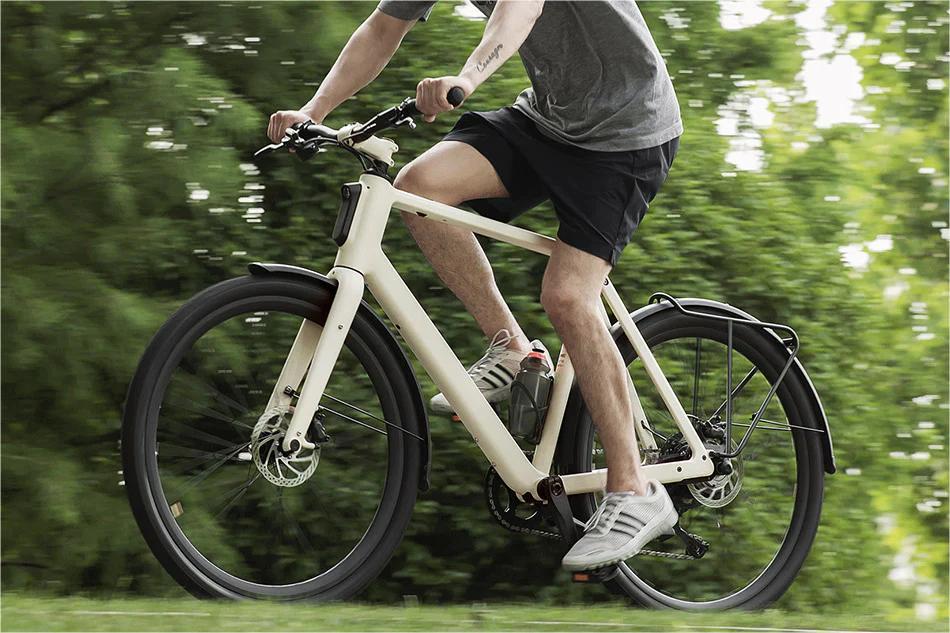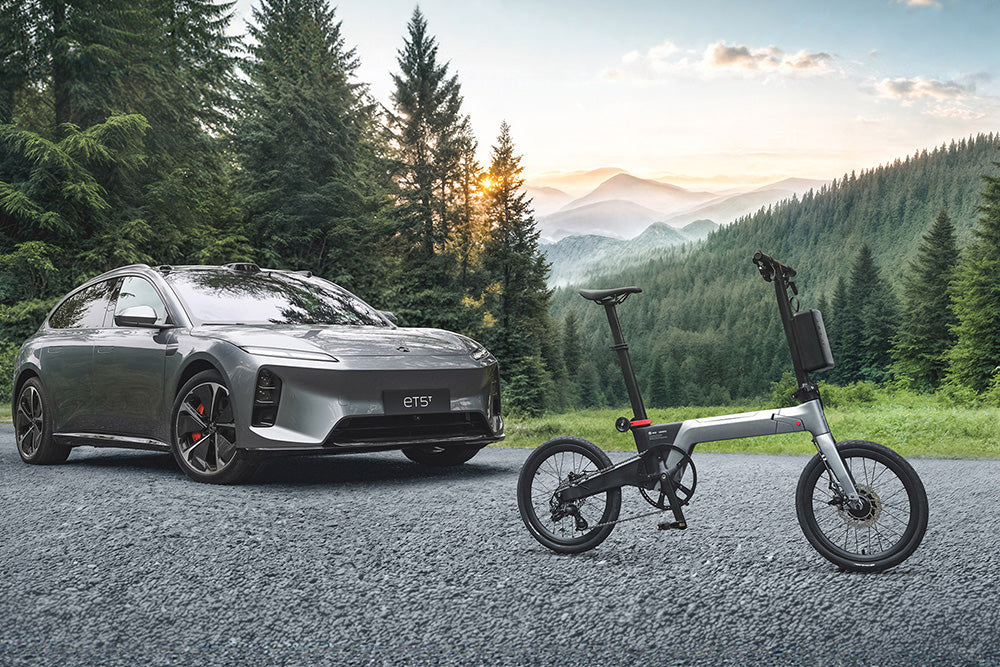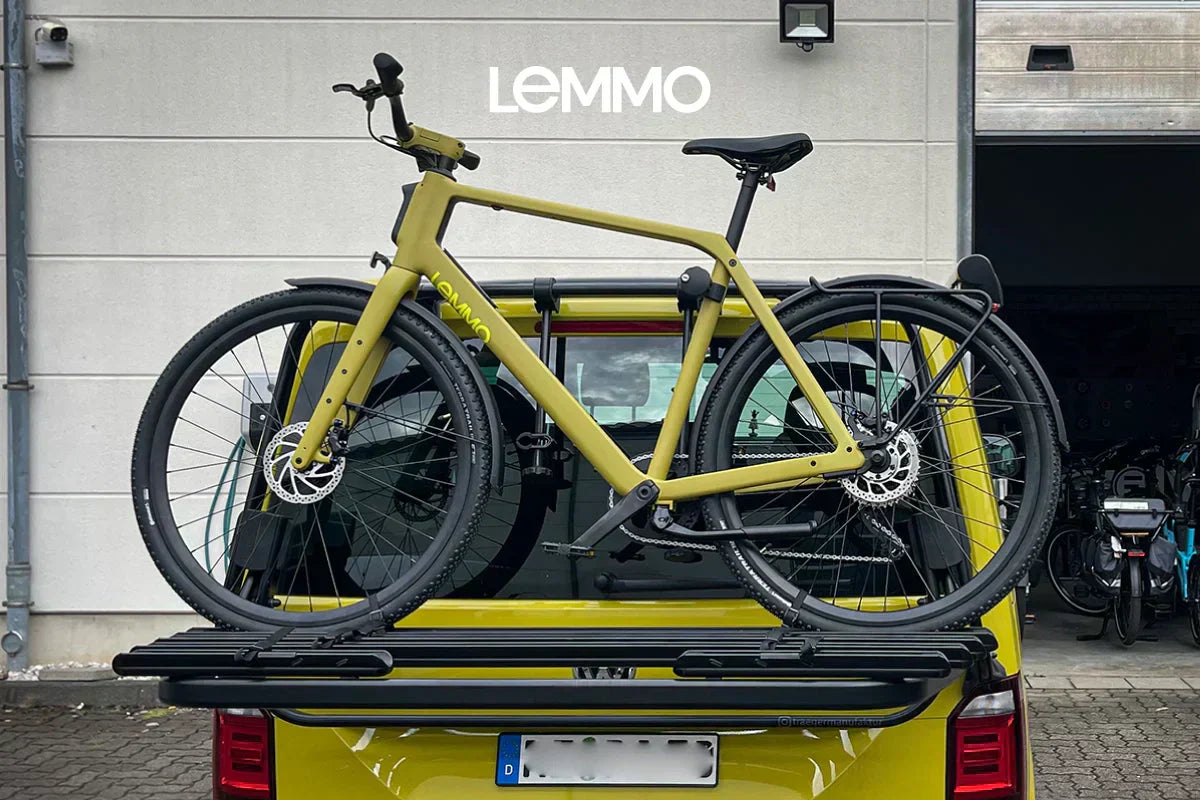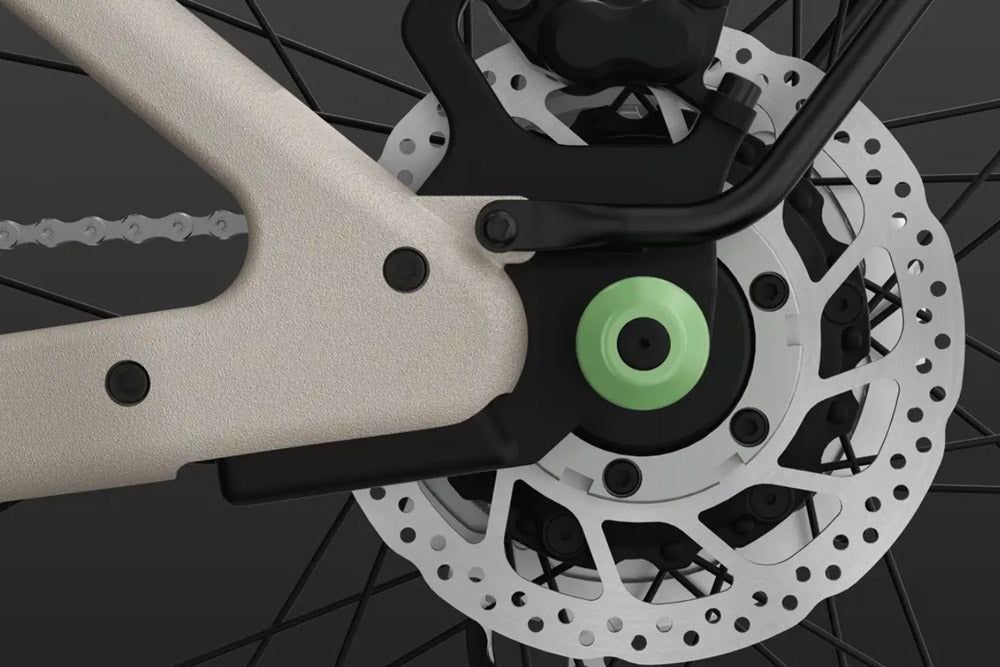E-bikes represent a fusion of traditional cycling and electric power, offering riders an enhanced experience that combines physical movement with the comfort of motor assistance. This unique combination places special demands on e-bike components, especially tires, which serve as a critical contact point between the bike and the ground. This guide explores e-bike tires and covers width, tread, and pressure - three aspects significantly affecting performance, safety, and comfort.
E-bike tires
An e-bike tire is a specially designed tire perfectly matched to the wheels of an electric bike. It is designed to handle the additional weight and higher speeds of e-bikes with confidence. These tires are characterized by durability, excellent traction, and support, suitable for different types of terrain and riding conditions.
Different types of e-bike tires
E-bike tires, like shoes on your feet, are designed with specific goals in mind, adapting to different terrains and riding styles to optimize your experience. Let's dive deeper into the spectrum of e-bike tires available:
- Road tires: These are the sprinters of the tire world, slim and efficient. Made for the smoothness of tarmac, their slim profile minimizes contact with the road and allows for a fast, unhindered ride. Ideal for commuters and speed lovers, road tires embody efficiency and propel you forward with less effort.
- Mountain bike tires: Off-road warriors equipped with rugged, aggressive treads dig into the earth for unmatched grip on muddy trails and rocky tracks. These tires are built to last, providing durability and control in environments where precision matters most. They transform rugged landscapes into manageable terrain for the adventurer in you.
- hybrid tires: The all-rounders, hybrid tires navigate the midfield with a tread pattern that is less aggressive than mountain bike tires but more substantial than road versions. They are versatile for riders traveling through city streets and venturing lightly into off-road excursions, offering a performance compound that can handle various conditions.
- Wide tires: The giants—with their significantly wider footprint—offer an unparalleled level of stability and traction. They are perfect for snow, sand, and everything in between. Their volume allows you to ride at lower pressures, creating a natural suspension effect and softening bumps and shocks on the road.
The key role of tire choice for e-bikes
- Performance: The compatibility of your tires with your intended terrain directly impacts how well your e-bike performs. The right tires can improve your bike's responsiveness, making every ride smoother and more enjoyable. They ensure the motor's power is effectively translated into movement, allowing for a seamless blend of speed and control.
- Safety and comfort: Tires serve as the first line of defense against the unpredictability of roads and trails. A well-chosen tire absorbs shocks and navigates obstacles, protecting you from the bumps and tremors of uneven surfaces. In addition, the stability provided by proper tires can make all the difference in preventing slips and falls, especially in less-than-ideal conditions.
- Efficiency and durability: Optimal tire choice can lead to significant savings in energy and costs. Tires that suit your riding conditions reduce the load on your e-bike's battery and motor, which can extend their lifespan. In addition, suitable tires wear less quickly and ensure that the need for replacements or repairs does not frequently slow you down.
E-bike tire width
The width of an e-bike tire refers to the measure of the cross-sectional diameter of the tire, which affects the bike's grip, stability, and rolling resistance. Wider tires provide better grip and comfort by absorbing more road vibrations, while narrower tires offer reduced rolling resistance and are typically faster on slippery surfaces.
The influence of tire width on performance
The width of an e-bike's tires is a crucial factor that shapes the bike's handling, efficiency, and overall ride quality. This characteristic affects how the bike interacts with different surfaces and impacts everything from traction to comfort.
- Wider tires: These are comparable to the off-road vehicles of the tire world, offering improved grip and stability that shine on rough, uneven terrain. Their larger surface area allows for better distribution of the rider's weight, resulting in improved traction. This attribute is especially beneficial when riding on loose gravel, wet surfaces, or any trail where control is paramount. Additionally, wider tires can absorb road vibrations and bumps more effectively, providing a ride that is noticeably smoother and more forgiving to the rider's body.
- Narrower tires: The road racers of the e-bike tire spectrum, narrower tires are designed for speed and efficiency. With less rubber on the road, they exhibit lower rolling resistance, meaning you can go faster with the same amount of pedal pressure or battery power. This makes them ideal for urban environments with smooth and paved surfaces where agility and quick acceleration are desired. They enable agile maneuvers and quick commutes and are the first choice for riders who want to maximize their speed.
How to choose the right width for your e-bike
Choosing the optimal tire width for your e-bike requires careful evaluation of your riding habits, preferences, and the typical conditions you will encounter.
- City rides: If your e-bike travels are mostly on city streets and paved roads, choosing narrower tires can improve your experience. These tires allow you to navigate traffic and traverse cityscapes with greater ease, making your ride faster and more efficient. The reduced rolling resistance also means you save battery power and extend the range of your e-bike on a single charge.
- Mixed terrain and off-road riding: Wider tires are the recommended choice for those who go beyond asphalt and explore trails, gravel paths, or different surfaces. Their superior traction and stability make them adept at handling the unpredictable elements of natural landscapes. The added comfort of their shock-absorbing capabilities also means you can tackle longer, more adventurous rides without the discomfort that might come from a narrower tire.
E-bike tire tread
The tread pattern of an e-bike tire describes the pattern of grooves and edges on the tire's surface, designed to improve grip, handling, and water displacement. Tread patterns range from smooth for optimal speed on paved roads to chunky for increased traction on off-road trails.
Tread patterns and their effects
Tire treads are designed much like the soles of shoes to interact with the ground in specific ways to provide grip, control, and safety. Understanding the role of different tread patterns is essential to optimize the performance of an e-bike in different conditions:
- Smooth profiles: These treads epitomize efficiency on smooth, paved surfaces. They minimize friction between the tire and the road without pronounced grooves, allowing for a fast and effortless ride. Smooth tires are perfect for urban commuters and road cyclists who prioritize speed and want to maximize their e-bike's battery life by reducing rolling resistance.
- Rough treads: With their rugged, aggressive design, chunky treads are built to bite into the terrain and provide unparalleled grip in the most needed environments. These tires are ideal for adventurers who use their e-bikes on trails, muddy paths, or off-road. The deep grooves and pronounced blocks help manage mud, shed dirt, and grip uneven surfaces, providing stability and confidence on challenging terrains.
- Intermediate treads: An all-rounder, intermediate, or hybrid treads balance the smooth efficiency of smooth tires and the aggressive grip of chunky tires. They feature a moderate pattern that is versatile enough to handle both asphalt and lighter off-road conditions competently. These treads suit riders who appreciate the flexibility to switch between urban landscapes and nature trails without changing tires.
How to match tread patterns to riding conditions
To improve the handling and safety of your e-bike, it is crucial to match the tread pattern of your tires to the environments in which you predominantly ride:
- For city riders: those who mainly ride on city streets and paved roads will benefit from smooth or semi-smooth tires. The reduced tread pattern maximizes contact with the road and provides a smooth and efficient ride. It is an excellent choice for e-bikers who want to cover distances quickly and with minimal effort, making it easier to maneuver through traffic and maintain higher speeds.
- For riders on mixed terrain: Tires with intermediate tread patterns are the best choice if your routes take you from paved roads to gravel paths or grassy parks. These tires are designed to adapt to different surfaces, offering good grip on loose material without sacrificing too much speed on asphalt. This versatility makes them ideal for riders who value flexibility and spontaneity in their adventures.
- For off-road enthusiasts: Riders who venture into the wilderness and tackle challenging terrain should opt for chunky tires. The deep treads provide superior traction on mud, sand, rocks, and roots and ensure stability and control when navigating unpredictable landscapes. These tires are critical for maintaining safety and performance in environments where conditions can change rapidly.
E-bike tire pressure
The tire pressure of an e-bike is the amount of air in the tire, measured in pounds per square inch (PSI) or bar, critical to influencing the tire's performance, comfort, and durability. Proper tire pressure ensures efficient riding, reduces the risk of punctures, and affects the overall stability and handling of the e-bike.
The role of tire pressure in performance and comfort
Tire pressure is not just a number - it is a crucial factor that influences the dynamics of your e-bike ride. It's the backbone of your cycling experience, affecting everything from how your bike takes corners to how smoothly it rolls over bumps and potholes.
- Handling and speed: Correct tire pressure ensures your e-bike is responsive and agile. When properly inflated, the tires provide the optimal shape and stiffness to respond precisely to your steering inputs. This precision in handling is essential for both safety and performance, allowing for faster maneuvers and maintaining speed.
- Comfort: Tire pressure is directly related to driving comfort. Tires that are too hard (overinflated) can make your ride jerky and uncomfortable as they transmit more road vibrations to the rider. On the other hand, underinflated tires can feel sluggish and increase the effort required to pedal while risking damage to the rim edge from bumps.
- Efficiency and tire life: Adequate tire pressure reduces rolling resistance, the force that opposes motion when an object rolls on a surface. Lower rolling resistance means you can ride faster and farther with the same amount of pedaling force or battery power. In addition, maintaining the recommended tire pressure extends the life of your tires by ensuring even wear and reducing the likelihood of punctures and sidewall damage.
How to find the optimal tire pressure for your e-bike
Finding the ideal tire pressure for your e-bike can significantly improve your riding experience:
- Consider the tire width: wider tires usually require lower pressure than narrower tires because they have a larger contact area with the ground. This increased footprint allows for better weight distribution and traction, which is particularly beneficial in off-road conditions or when carrying heavy loads.
- Consider rider weight: Your weight plays a significant role in determining the ideal tire pressure. Heavier riders need higher pressure to prevent the tires from flattening too much under load, which could lead to punctures or rim damage. Conversely, lighter riders may benefit from slightly lower pressures to improve comfort and traction.
- Adapt to the riding conditions: The optimum pressure also depends on your riding surfaces. Rough, uneven terrain may benefit from slightly lower pressures for better grip and shock absorption, while smooth, paved surfaces allow higher pressures for increased efficiency and speed.
- Follow the manufacturer's recommendations: Always start with the tire manufacturer's recommended pressure range, usually found on the tire sidewall. This range is a guideline based on the tire's design and intended use. Experiment within this range to find out what works best for you, taking into account your weight, riding style, and the typical conditions you encounter.
Regularly checking and adjusting your tire pressure before rides can prevent common bike problems, from uncomfortable rides to unnecessary wear and tear on your e-bike. Investing in a reliable bike pump with a pressure gauge and making tire inflation part of your pre-ride routine is a good practice. By setting your tire pressure to the ideal point, you'll enjoy a ride that's not only smoother and more efficient but also safer and more enjoyable.
Care and maintenance of e-bike tires
Proper maintenance and regular care of e-bike tires are crucial to ensure the longevity and safety of your ride. Tires are your direct connection to the ground and are crucial in handling, comfort, and efficiency. Here's how to keep them in top condition:
Regular inspections and cleaning
- Routine inspections: Get into the habit of checking your tires before and after trips for signs of wear or damage. Look for cracks in the rubber, significant tread wear, or sharp objects that may have become lodged in the tire. Early detection of these issues can prevent flats during your rides and extend the life of your tires.
- Tire cleaning: Regular cleaning isn't just for aesthetics; it's a practical measure to maintain tire integrity. Use a brush and soapy water to gently clean the tires to remove dirt, grime, and small stones that may be stuck in the tread. This helps uncover hidden problems such as cuts or dents and improves traction by keeping the tread clear.
Tire replacement and repair
- Wear Detection: Tires naturally wear out, but certain signs indicate it's time for a replacement. If the tread is flattened or you notice repeated punctures in the same area, this is a clear sign that the tires are reaching the end of their service life. In addition, visible damage, such as deep cuts or dents on the sidewall, indicates that tire safety is compromised and requires immediate attention.
- Timely repairs: In minor punctures and damage, quick repairs can save a tire and keep you on the road. Repair kits are available for patching small punctures, a useful skill for any e-bike rider. However, larger damage or wear patterns may not be safely repairable, necessitating a tire change.
- Professional assessment: If in doubt, seek the advice of a professional. Bike stores can conduct detailed inspections and advise whether a tire can be repaired or replaced. This is especially important for e-bikes, as their higher speeds and weights put additional stress on the tires.
Proactive tire care tips
- Pressure checks: Regularly check your tire pressure with a high-quality gauge and adjust it according to your driving conditions and weight. Proper inflation is key to preventing punctures and ensuring optimal performance.
- Rotate tires: Consider rotating your tires regularly to promote even wear, especially if you notice one tire wearing faster. This can extend the overall life of your tires.
- Upgrade when necessary: The technology in e-bike tires constantly evolves, offering better grip, efficiency, and puncture protection. Upgrading to high-quality tires can be a worthwhile investment in your riding experience.
Regular inspections, cleanings, and timely interventions will keep your tires in optimal condition so you can focus on enjoying your ride with confidence in your bike's reliability and performance.
Conclusion
E-bike tires are critical components that require careful consideration and regular maintenance. By choosing the right tire for your needs in terms of width, tread pattern, and pressure and performing routine inspections and maintenance, you can significantly improve the performance, safety, and riding enjoyment of your e-bike. Whether commuting through city streets or exploring rough trails, the right tires provide the foundation for a smooth, efficient, and enjoyable ride.




